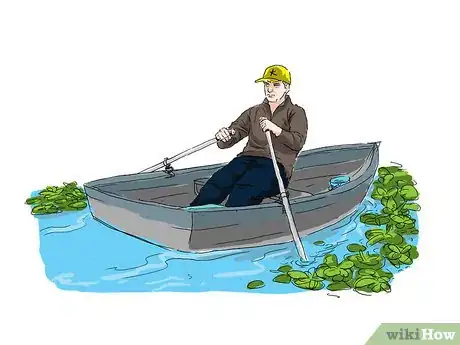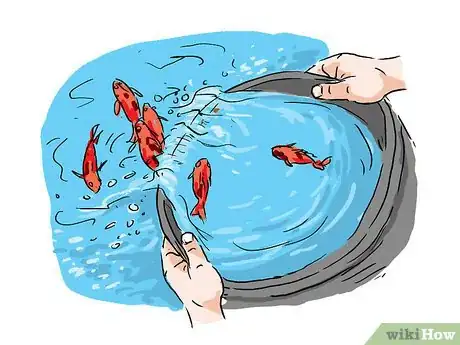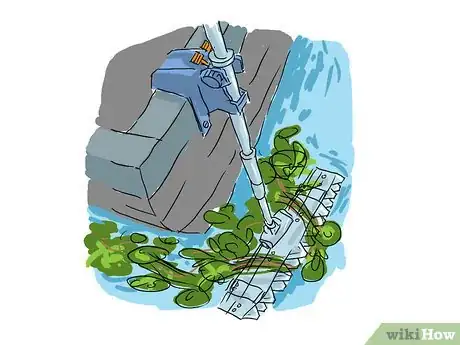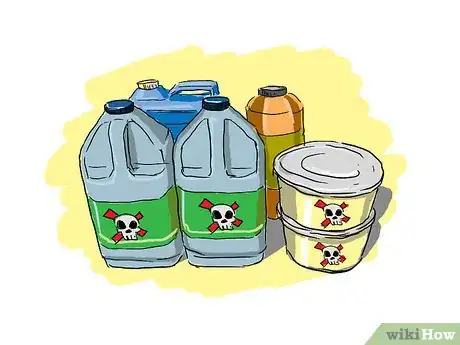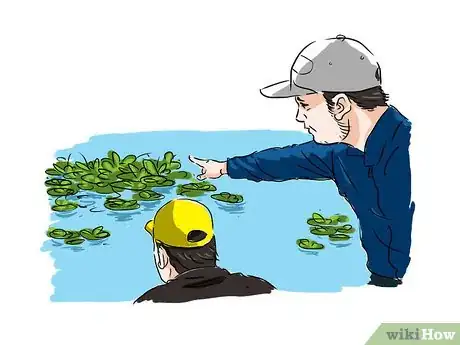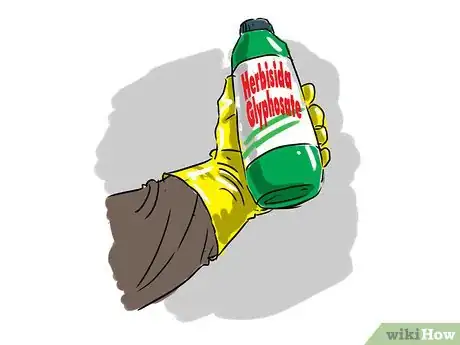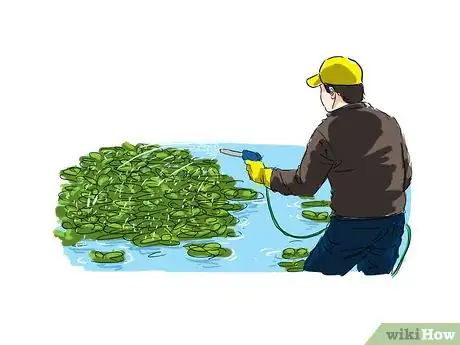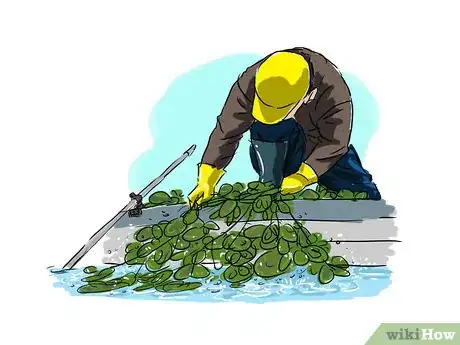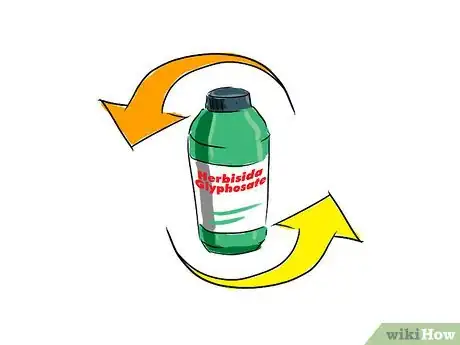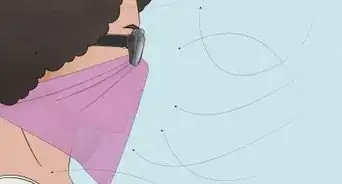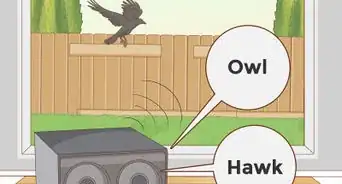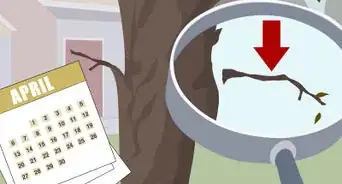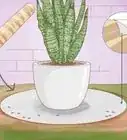wikiHow is a “wiki,” similar to Wikipedia, which means that many of our articles are co-written by multiple authors. To create this article, volunteer authors worked to edit and improve it over time.
This article has been viewed 183,891 times.
Learn more...
Lily pads are frequently appreciated for decorative purposes, but occasionally, the lily pad population in a pond or lake can explode. If over half the water is covered by the pads, you may have a problem on your hands. Lily pads can either be removed physically or chemically, but both methods can be time consuming. It is not recommended for you to remove all of the lily pads floating on a body of water, either, since they often serve oxygenate the water for fish and provide shade for all sorts of underwater aquatic life.
Steps
Physical Removal
-
1Row a boat through the lily pads. If the body of water in question is a lake or a large pond, and you want to remove the lily pads to provide a path for boats, simply rowing the boat through the lily pads is often enough to open a path and keep it opened.[1] It is best to do this with a rowboat, rather than a motorized boat, since the pads could potentially get caught in the blades of a motor.
-
2Rake away the lily pads. If the pond is relatively undisturbed and the roots of the pads are not too tangled, surface raking is a viable solution to remove lily pads. Row a boat into the middle of the pond, or wade to the center of the pond if the water is shallow enough. Use a standard garden rake to pull the pads off the surface of the water. Some hardier varieties may have resistant roots that make surface raking difficult, and you may not be able to remove the pads at the root. This works well as a short-term solution, but the lily pads will often re-grow afterward.Advertisement
-
3Fill the pond with fish. If the pads are growing in your own private pond, adding several grass carp (note grass carp is a non-native species and may be invasive) or other fish that dine on water lilies can naturally reduce the amount of pads that form on the surface. Typically, adding two fish per acre of water is an effective amount. The fish should be young, since young fish eat more than older fish.
-
4Use a spade. This method works best with shallow ponds that you can wade into, and is difficult to accomplish with deeper ponds and lakes. While standing in the water, drive the metal edge of the spade beneath the root of the lily pad. Loosen the root from its place and then lift the freed pad off the surface of the water. This solution can take a long time to accomplish, and it may be difficult to use it if you have a large pond and are working by yourself. It proves effective, though, and literally removes the lily pads at the root of the problem.
-
5Try an aquatic mower. An aquatic mower is a specially designed tool that works like a weed cutter, except that it trims away weeds and vegetation that grows on the surface of a body of water. It is usually used against algae and seaweed, but it also works against lily pads. The mower can be used from a boat, so it works in deep ponds as well as shallow ponds.
Chemical Removal
-
1Use chemicals after the primary flowering period has ended. Chemical treatment is most effective and least likely to cause permanent damage to your pond's ecosystem when the season's first batch of lily blooms have died off.
-
2Figure out where to apply treatment. Chemicals are usually applied from the center of the pond outward, doing small sections at a time. Spraying an entire pond at once can cause too many plants to decompose and may rob the aquatic life living beneath the surface of valuable oxygen. To avoid this, apply the treatment to the most overgrown areas of the pond first before tackling other small sections after a few weeks pass.
-
3Apply an agricultural surfactant. Applying an herbicide directly to the lily pad may work, but oftentimes, you will need to apply a surfactant beforehand to dissolve the protective wax coating on the outer surface of the pad. Spray the surfactant onto the top of the pad liberally.
-
4Choose the right type of herbicide. Glyphosate-based herbicides are the most commonly used for lily pad removal, but imazapyr-based herbicides will also work. Both are broad spectrum, non-selective herbicides that essentially kill any surface plant they come into contact with, but neither kills plants that live under the surface of the water.
- Please note: The WHO considers glyphosate to be a probable human carcinogen. Its use is prohibited in some states and countries. Please check with your local laws and use caution if handling this chemical.
-
5Apply the herbicide to the top of the pads.[2] Follow the instructions on the herbicide's label to determine an appropriate dosage. Usually, aquatic herbicides are sprayed directly over the top of the lily pad until the surface is thoroughly and evenly coated.
-
6Rake away the dead lily pads. The herbicide will kill the plant, leaving dead plant matter floating on the surface. Wade or row into the water and rake away dead lily pads. Pull up the roots, if possible. While the herbicide should have killed the roots, it will not be good for your pond if too many dead roots linger at the bottom and are allowed to decompose.
-
7Repeat this process over several weeks. Wait two to three weeks in between applications, spraying one small section at a time to prevent the ecosystem of the pond from becoming unbalanced. After the entire pond has been covered, go back over areas that were already treated if too many of the lily pads survived the initial application.
Community Q&A
-
QuestionWill the roots come to the top and look like mud?
 Community AnswerYes. The large root systems become buoyant as they die and gasses build in them and they will float up, bringing muck with them. This can create tussocks and can be very large and hard to remove.
Community AnswerYes. The large root systems become buoyant as they die and gasses build in them and they will float up, bringing muck with them. This can create tussocks and can be very large and hard to remove. -
QuestionMy pond is empty right now for repairs, and the lily pads are visible. The roots are very hard to pull out. Is there something safe to kill the pad? If I clip off the lily at the base, will it regrow?
 BookLover6Community AnswerYou may want to use chemicals to kill the roots. If you clip the lily at the base, it will regrow.
BookLover6Community AnswerYou may want to use chemicals to kill the roots. If you clip the lily at the base, it will regrow. -
QuestionIf pads manually pulled and float away will that pad re-root and grow?
 Community AnswerOn most occasions no, but if you don't follow all steps, it may have the chance of regrowing.
Community AnswerOn most occasions no, but if you don't follow all steps, it may have the chance of regrowing.
Warnings
- Know your state's laws concerning the removal of aquatic plants. Unlawful removal could result in fines. If removing lily pads in a backyard pond that sits on your property, the regulations governing the process will usually be fairly loose, but a permit may be required depending on how large the body of water is. For many states, though, the removal of lily pads or other aquatic plants from public waters is not allowed.⧼thumbs_response⧽
- Wear protective gear when removing lily pads from your pond or lake. At minimum, you should wear waterproof boots and coverings whenever you wade into the lake to apply a treatment. When using chemical treatments, you should also wear protective gloves and goggles.[3]⧼thumbs_response⧽
Things You’ll Need
- Boat
- Rake
- Fish
- Spade
- Aquatic mower
- Agricultural surfactant
- Aquatic herbicide
References
About This Article
You may want to remove some lily pads if there are too many, but don't remove all of them since lily pads oxygenate the water and provide some shade for the fish. To remove lily pads with chemical treatments, be sure to wait until after the primary flowering period has ended to avoid damaging the ecosystem in the pond. Spray an even coating of a glyphosate-based herbicide over the top of the lily pads. Then, after the lily pads die, simply rake them away to remove them or row a boat through them to clear a path in the water. For more information on removing lily pads, like how to remove them using an aquatic mower, read on!
